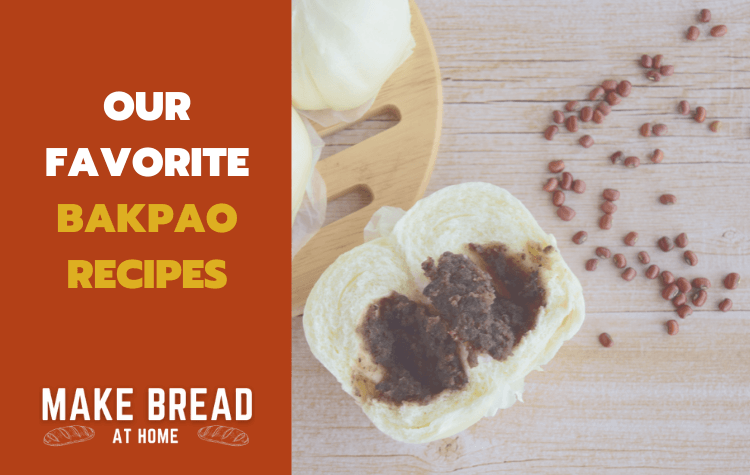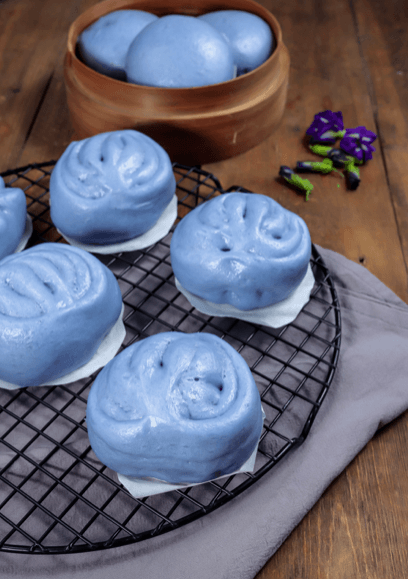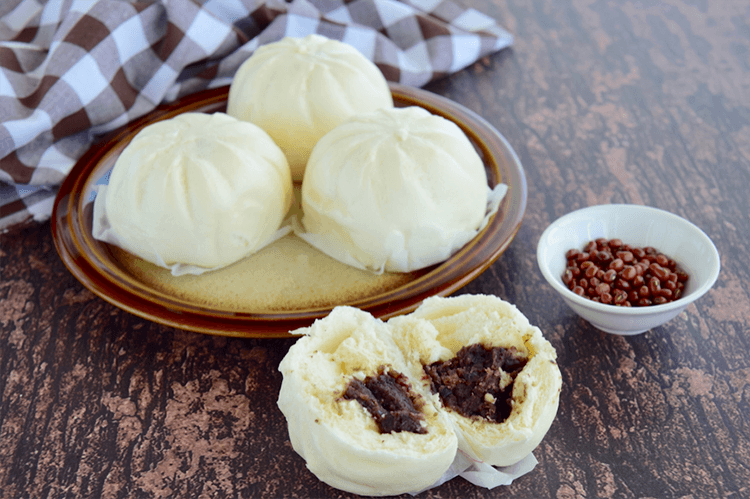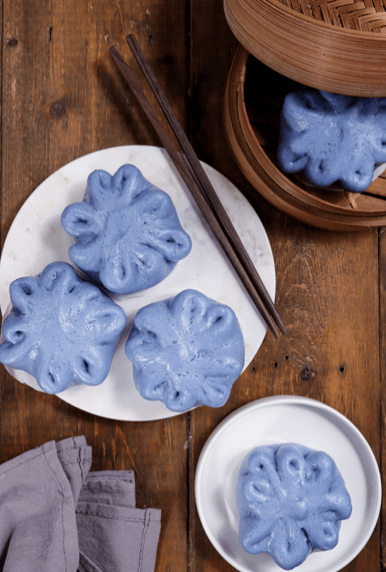If you’re ever in the mood for a twist on bread buns, why not try bakpao?
Bakpao is a type of baozi, or a filled bun that originates from China. For those who’ve never tried it before, imagine a bread bun with a savory filling. Bakpao is very similar, only its bun has a more neutral taste, with a light and airy texture, and it’s white in color. This makes the filling more prominent than with other bun types.
If you’re looking for a healthier and lighter alternative to bread buns, bakpaos are a great alternative. Even better, they’re very easy to make; they only require a few ingredients and can be steamed instead of baked.
Where do you start with a Bakpao recipe? Let’s dive into the history of this food, and then explore how to make your own – with tasty fillings!
History and Origins of the Delicious Bakpao

Bakpao, also spelled bakpau, bah-pau, or bapao, traces its name from the Hokkien word that translates to ‘meat bun.’ In China, it often refers to a bun that is usually filled with pork.
At present, it’s found almost everywhere in China, from fancy restaurants to street food hawkers. The bakpao can also be found in countries with Chinese influence, with their own takes on the meat bun.
In Indonesia, the bakpao is larger (a size called dabao) at about four inches in diameter. Because of Indonesia’s Muslim majority, their bakpao is filled with pork alternatives, such as minced beef, diced chicken, and even bean paste.
Bakpao can also refer to Thai steamed buns, sometimes called salapao; its filling ingredients can include bamboo, dried shrimp, and Thai spices.
Our Favorite Bakpao Recipe
The bakpao has two main elements: the bun and the filling. The bun is a simple yeasted dough, with techniques familiar to any baker. However, the texture and ingredients may be unfamiliar; otherwise, creating the bun is easy and straightforward.
Ingredients
- 1 cup of flour.
- 1 tablespoon of yeast.
- 1/2 cup of milk.
- 1/4 cup of water.
- 1 teaspoon of sugar.
Procedure
- Activate the yeast by adding lukewarm water. Let it sit for five minutes, or until it bubbles. If it doesn’t bubble, start again with a new packet of yeast.
- Mix the water and sugar until the sugar has dissolved.
- Sift the flour and baking powder into a bowl.
- In another bowl, mix the yeast, sugar, and one to two tablespoons of flour into a paste. Cover this with a damp cloth and let it rest for ten minutes.
- After ten minutes, add this paste into the flour-and-baking-powder mixture. Add the milk and water slowly, watching your dough’s texture as you go. The ideal texture should be smooth but not sticky.
- Roll the dough into a ball and cover it with a damp cloth. Let rise for at least an hour. While resting, create your dough filling.
- After resting, shape the dough into a sausage.
- Cut the dough into ten to twelve pieces. Roll each piece into a flat circle; it should be about 1/3 inches thick, and four to six inches in diameter.
- Add two tablespoons of filling to the center. Fold the sides shut and seal the edges with water. (You can close your bakpao in many ways; we discuss some techniques below.)
- Allow the buns to rise for at least ten to thirty minutes under a damp cloth.
- Steam the buns one layer at a time for ten to fifteen minutes.
Can You Make a Bakpao in a Bread Machine?
Like most steamed buns – and bao dough in general – bakpao can be kneaded in a bread machine. That’s great if you’re preparing a lot of dough, or if your filling prep takes longer than the rising time of the dough.
So, how do you work with bread machine bao dough?
- Activate the yeast. Combine yeast and lukewarm water until the mixture bubbles – about five minutes. If the mixture does not bubble, use a new yeast packet.
- Add in the flour, baking powder, salt, and sugar. Turn on the machine.
- Slowly add in the milk and water, checking the texture of your dough.
- Once you’ve added all the milk and water, slowly add the oil.
- Keep kneading until your dough reaches the right consistency: smooth and not too sticky. If you’ve added too much liquid, incorporate a teaspoon of flour until you reach the right consistency. Kneading should take about ten to fifteen minutes.
- Cover the dough with plastic, and let it rest for about forty-five minutes to an hour. After resting, it should have doubled in size.
- Roll out your dough in a sausage shape. Cut the dough into ten to twelve pieces. Roll each piece into a ball and flatten with a rolling pin. The circles should be about 1/3 inches thick, with a diameter of about four to six inches.
- Fill each piece with two tablespoons of filling. Fold each piece closed.
- Let the buns rest for ten to thirty minutes; after resting, it should have grown 1.5 times its original size.
- Steam the buns for ten to fifteen minutes.
Bakpao Filling Ideas

The traditional bakpao is filled with minced pork, but there are many ways to create your own filling. Here are some recipes to try.
Classic Pork Filling
For the original bakpao flavor, you need a pork filling. This pork filling recipe uses minced pork with herbs to create the classic taste.
This recipe is also a great base if you want to keep the traditional bakpao flavor without having to use pork. Substitute the minced pork with minced beef, minced chicken, or vegetables; just remember to adjust all other ingredients to taste.
Ingredients
- ½ cup of minced pork.
- 1 tablespoon of oil.
- 1 tablespoon of chopped onion.
- 2 teaspoons of garlic powder (or 2 garlic cloves, juiced).
- 1 teaspoon of sugar.
- 1 teaspoon of soy sauce
- 2 tablespoons of chopped celery
Procedure
- Heat the oil in the pan.
- Fry the minced pork until it is thoroughly cooked, for about one minute.
- Add onions, garlic juice, celery, sugar and soy sauce. Cook for two minutes.
- Let cool.
Red Bean Paste

Adzuki bean, or red bean, is a staple ingredient in many Chinese deserts. For those seeking a meat-free bakpao filling, the red bean paste is ideal.
Featuring a deep red color, red bean paste has a delicate sweetness, with a jammy texture that can be smooth or chunky. It can be found in many Asian markets, but you can also create your own, especially if you want to monitor the sugar content.
Ingredients
- 1 ¼ cups of azuki bean.
- 1 cup of white sugar.
- 1/8 teaspoon of salt.
Procedure
- Cook the red beans. Soak the beans in room-temperature water overnight.
- Discard the water, and then transfer the beans with 4 cups of water to a large pot.
- Bring the pot to a boil, then simmer at the lowest heat setting for about an hour. Make sure that the beans are fully covered with water throughout. Stir the beans occasionally.
- After boiling, the beans should be soft enough to mash with a spoon.
- Alternatively, you can use a pressure cooker – cooking the beans with three cups of water at medium heat until the rated pressure is obtained. Then, lower the heat to the lowest setting and cook at high pressure for twenty minutes.
- If using a pressure cooker, turn off the heat and let the pressure release. Do not remove the pot from the cooker or stove.
- Add the sugar and raise the heat to medium-high. Let the beans boil until the mixture thickens. To determine if the mixture is thick enough, scrape the bottom of the pot. You should see the bottom of the pot for one to two seconds.
- Remove from the heat and transfer to a bowl. Once it has cooled down, let it chill in a fridge. The mixture will continue to thicken as it becomes colder.
Coconut and Sugar Filling
While not a traditional Chinese filling, this coconut and sugar bakpao filling is common in Indonesia.
The combination of coconut and sugar brings the usual savory meat bun squarely into desert territory with a sweet and slightly crunchy texture. What’s great about this filing is that you can roll it into a ball, making the bakpao much easier to shape. For beginners, and for those serving this dish to people with a sweet tooth, this is the filling for you.
Ingredients
- 1 cup of grated unsweetened coconut.
- ½ cup of coconut sugar.
- ¼ teaspoon of salt.
- 1 tablespoon of all-purpose flour.
Procedure
- Mix all the ingredients, save for the flour, together in a bowl.
- Place the mixture on a medium-sized skillet, and stir-fry over medium heat until the sugar dissolves. Then, continue mixing until the mixture becomes dry.
- Stir in the flour and remove from heat.
Closing the Bakpao
There are many ways to close a bakpao; some are prettier than others, and some are faster. Pick the technique that is most comfortable to you. When you have the hang of closing bakpaos, try creating your own techniques!
Traditional
Whether in a dim sum restaurant or a Chinese street food vendor, if you’ve eaten an authentic bakpao, chances are, it was closed with this technique.
The traditional technique creates very minimal folds. It’s a very fast method, but it can lead to too much dough on top of the bun. Nonetheless, if you want a classic look to your meat buns, try this:
- Take two opposite edges of the dough and lift them to meet at the center of the bakpao. Pinch it closed.
- While still pinching the first fold, take one of the open edges, and bring its center. Pinch these three sides together with your other hand and let go of the first pinch.
- Do the same for the other side.
- Take the flaps of one side and pinch with one hand. Do the same for the other side.
- Bring these together towards the center, squishing the tops to close the bakpao. Close any open seams with more pinches; the dough should hold itself together. Add more water if it doesn’t stick.
Flat Top
Want a simpler way to close your bakpaos? Try removing the seam!
This technique creates a smooth top, giving your bakpaos a sleek and minimalist look. This is also a great way to close bakpaos if you’re not confident in your methods.
The drawback is? It takes longer than other techniques, since you have to smooth down the bottom of the buns.
To use this technique, just:
- Fold the sides of the bakpao towards the center. This will take about four folds.
- Flip the bakpao over onto a flat surface, so that the seams are at the bottom.
- Cup your hands around the bakpao and turn it so that the bottom scrapes along the flat surface.
- Press the sides of the bakpao with your cupped hands as you turn it, easing it into a circular shape. You may need to gently pat down the top of the bakpao to create a dome.
- Once it’s reached a circular shape, smooth over the top by cupping a hand over the dome and rolling it.
- Pat the sides of the bakpao.
Ornamental
This technique is more complicated and takes slightly longer. However, it’s easier to do, since you’ll create folds along the seam of the dough, instead of ensuring that the bakpao remains closed as you go. Additionally, this technique results in a shape that looks like a flower – making it great for a more decorative approach!

Here’s how to pull it off:
- Lift one part of the seam towards the center of the bakpao and pinch.
- While holding this pinch, take the space to the right or left of the seam, and lift it towards the pinch you made. Pinch it at the base of the first pinch you made, so that it creates a type of wave.
- Continue going along the seam, until you reach the other end. You can leave an opening for the steam, if you like.
The bakpao is a great way to delve into new dishes!
If you’re in the mood for something lighter, healthier, and new, why not try your hand at one of these delicious recipes?
